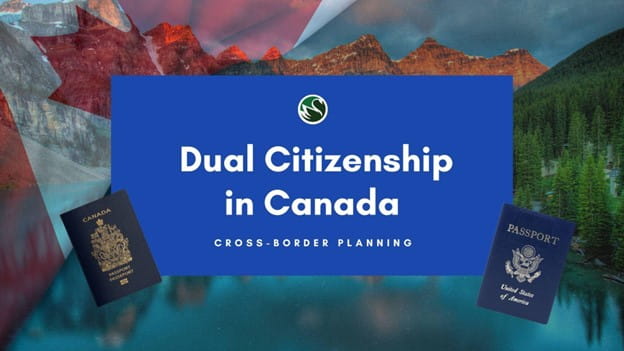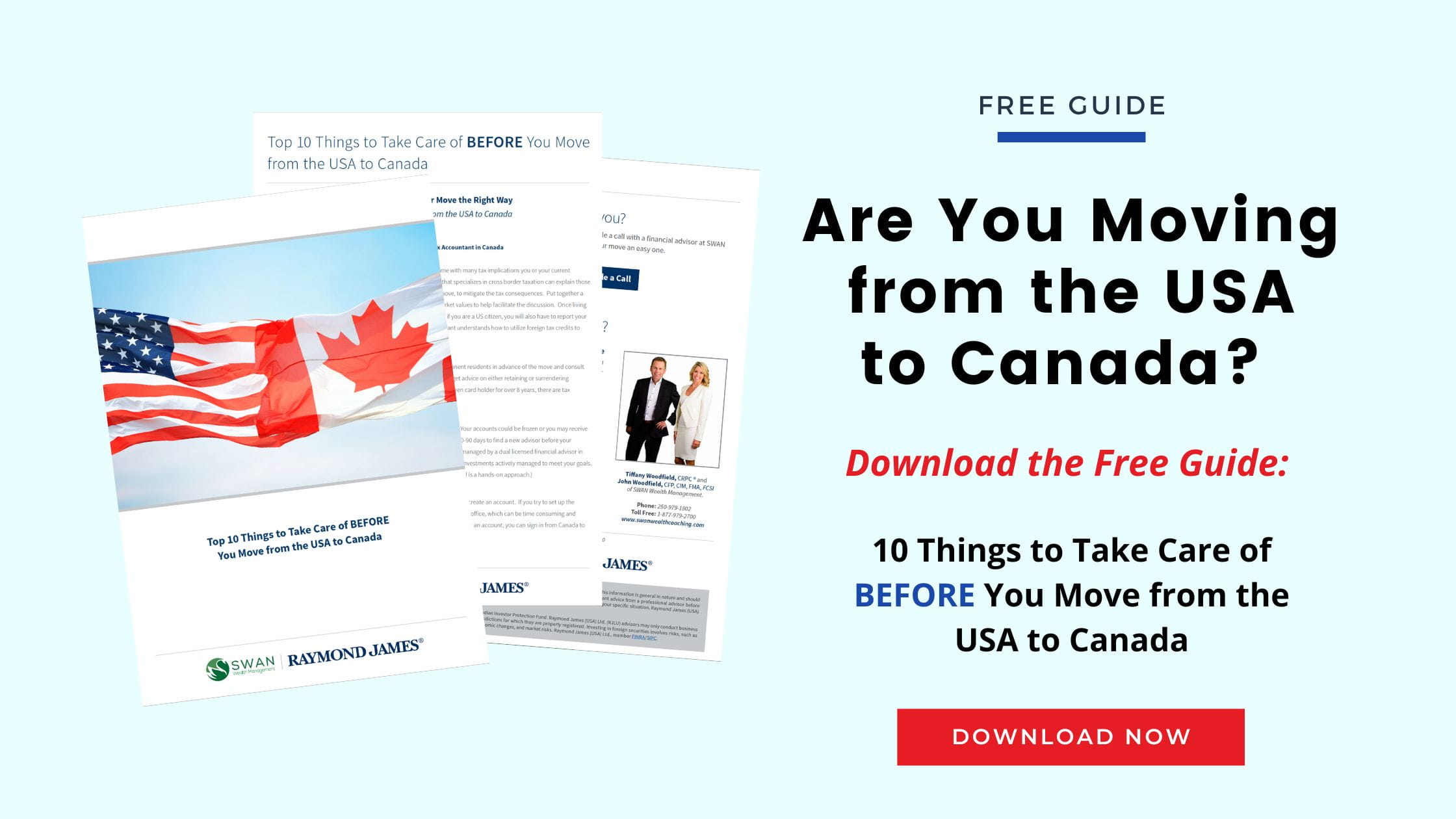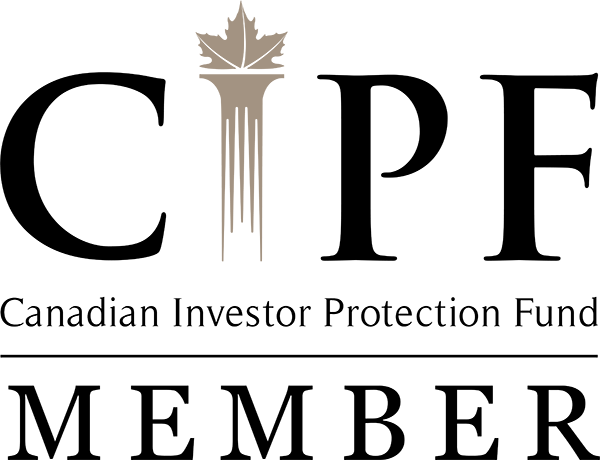How to Get Dual Citizenship in Canada
Written by Tiffany Woodfield, TEP, Associate Portfolio Manager, CRPC®, CIM®

Are you exploring how to get dual citizenship in Canada?
Understanding the process and requirements can feel like navigating a complex maze of rules. If you're curious about eligibility criteria, the application process, or the implications of holding dual citizenship, this post will help. We'll cover the basics of obtaining dual citizenship in Canada, including the steps and benefits.
As cross-border financial advisors working with families in both Canada and the US, we'll write this post with a focus on US and Canadian citizens.
However, the rules for dual citizenship in Canada apply to everyone, not just Americans.
Additionally, we recommend working with a cross-border attorney when pursuing dual citizenship, as this may reduce the headaches and stress involved in this paperwork-heavy process.
Key Things to Know About Dual Citizenship in Canada
Here are the most important facts to remember if you're considering becoming a dual citizen:
- The Canadian government allows dual citizenship, so you can keep your previous citizenship.
- You can obtain citizenship through naturalization, descent, or by being a child born in Canada.
- Naturalization means applying for Canadian citizenship after living in Canada as a permanent resident.
- Descent means you may get Canadian citizenship if one of your parents is Canadian, even if you were born outside Canada.
- If you have a Canadian parent, you may qualify for Canadian citizenship through descent.
- A child born in Canada usually gets automatic Canadian citizenship, even if the parents have foreign citizenship.
- A birth certificate may be needed to show proof of a parent’s citizenship or your Canadian birth.
- To apply through naturalization, you must show physical presence in Canada for at least 1,095 days.
- You will need to prove basic language skills in English or French.
- You must pass a citizenship test on Canadian rights, responsibilities, and history.
- After becoming a dual citizen, you should travel with both your Canadian passport and the passport from your other country.
Understanding Dual Citizenship in Canada
Dual citizenship means you can legally belong to two countries at the same time.
If you’re a US citizen living in Canada, you don’t have to give up your US passport to become Canadian. Canada allows you to hold citizenship in another country, and so does the United States. This gives you legal rights and responsibilities in both places.
You can vote in both countries, hold two passports, and access services like healthcare or social security, depending on where you live. But with those benefits also come obligations such as taxes and legal requirements. So, it’s smart to understand how these rules work together before applying.
How to Get Your Canadian Citizenship
To become a Canadian citizen, you must first become a permanent resident.
Most Americans start by applying for permanent residency through family sponsorship, work permits, or spousal sponsorship. After living in Canada as a permanent resident for at least three out of the last five years, you can apply for citizenship.
You’ll also need to show that you’ve filed Canadian taxes and passed a citizenship test. The test covers basic Canadian history, geography, laws, and rights. Once approved, you’ll attend a ceremony and take the Oath of Citizenship.
This process sounds straightforward, but each step comes with detailed paperwork, timelines, and fees.
Pathway |
Key Requirements and Eligibility |
|
Naturalization |
● Must be a permanent resident of Canada. ● Must have lived in Canada for at least 1,095 days in the last 5 years. ● Must file Canadian taxes for at least 3 years within that period. ● Must demonstrate basic language skills in English or French. ● Must pass the Canadian citizenship test. ● Must attend a citizenship ceremony and take the Oath of Citizenship. Applies to foreign nationals who moved to Canada and became permanent residents. |
|
Descent |
● Must provide proof that at least one parent was a Canadian citizen at the time of your birth. ● Must apply for a citizenship certificate. ● Must submit supporting documents such as your birth certificate and your parent’s proof of Canadian citizenship. ● Applies to individuals born outside Canada to a Canadian parent (first generation only). |
|
Birth |
● Must be born on Canadian soil. ● No application needed, but you may need a birth certificate as proof. Applies to any child born in Canada, except those born to foreign diplomats or exempt persons. |
Dual Citizenship Rules in Canada
Canada won’t ask you to give up your original citizenship when you become a citizen.
The US also doesn’t require you to renounce your US status if you become a Canadian. But it’s important to know that both countries expect you to obey their laws. That means filing taxes in both places, even if you live mostly in Canada.
If you have children, dual citizenship can affect their status too. And if you hold certain government jobs or serve in a foreign military, it could raise legal questions. It’s best to get advice before making a move.
Pros and Cons of Dual Citizenship in Canada
One of the biggest advantages of dual citizenship is flexibility.
You can live, work, and study in both countries without needing visas. You can access public services, buy property, and pass citizenship to your children. For many families, this adds peace of mind and options for the future.
But there are also drawbacks.
You may have to file taxes in both countries and follow legal rules in each. This can get complicated, especially if your assets or income cross borders. And in some cases, holding two citizenships may limit your eligibility for certain government roles.
Ways to Obtain Dual Citizenship in Canada
There are a few main paths to dual citizenship in Canada, depending on your situation.
If you’re an American in Canada, one common way is to become a permanent resident, live in Canada long enough, and then apply for Canadian citizenship.
If you were born in Canada but live in the US, you may already be Canadian by birth.
Another route is through descent—if one of your parents is Canadian, you might be able to claim citizenship. The US has similar rules. You may be American by birth, descent, or naturalization.
Requirements for Dual Citizenship
To hold dual citizenship, you must follow the rules in both countries.
In Canada, to become a citizen, you need to:
- Be a permanent resident
- Live in Canada for at least 1,095 days in the past five years
- File Canadian taxes for at least three years during that time
- Show you can speak English or French at a basic level
- Pass the Canadian citizenship test
- Attend a citizenship ceremony and take the Oath of Citizenship
In the United States, to keep your citizenship while becoming Canadian, you need to:
- Continue following US tax and reporting rules
- Avoid actions that show intent to give up US citizenship
- Keep using your US passport when entering or leaving the United States
Citizenship by a Parent’s Naturalization
Children may become Canadian citizens when a parent becomes one, but it depends on the situation.
If a child is under 18 and a permanent resident, they can usually gain citizenship through a parent’s naturalization. The parent must already be a Canadian citizen or be applying for citizenship at the same time. In most cases, the child does not have to meet the physical presence or language requirements. However, a separate application for the child is still needed. The process can vary based on custody and family status, so it’s best to get advice from a cross-border immigration lawyer before applying.
Automatic Citizenship for Children Born in Canada
If your child is born in Canada, they are automatically a Canadian citizen.
Canada follows the rule of birthright citizenship. This means any child born on Canadian soil is granted citizenship at birth—no application or residency requirement needed. It doesn’t matter if the parents are citizens, permanent residents, or on temporary visas.
The child still gets full rights as a Canadian, including access to healthcare, education, and the ability to apply for a Canadian passport. This rule does not apply to children born to foreign diplomats, but it does apply to almost everyone else.
That’s one of the simplest paths to citizenship in Canada.
Tax Implications of Dual Citizenship
Dual citizens need to file taxes in both countries—even if they live in just one.
If you're a US citizen living in Canada, the IRS still expects you to file a US tax return every year. You also have to report certain foreign accounts and assets.
At the same time, Canada requires tax filings based on where you live and earn income.
Thankfully, the Canada-US tax treaty helps prevent double taxation. But the paperwork can still be complex, especially with investments or retirement accounts. Working with a cross-border financial advisor and accountant is the best way to stay compliant and avoid costly mistakes.
Renouncing Citizenship
Some people choose to renounce their citizenship, but it’s a serious and permanent decision.
You might consider giving up US or Canadian citizenship to simplify taxes, reduce legal obligations, or align with personal goals. In the US, renouncing your citizenship involves an in-person interview at a US embassy or consulate, paperwork, and a fee. You also need to be current on your taxes.
Canada has a similar process, though fewer people renounce Canadian citizenship. Once renounced, it’s very hard to get it back. Before making this move, speak with a cross-border advisor and lawyer to understand the long-term consequences. For many people, there's no need to renounce their US citizenship.
Maintaining Dual Citizenship
As a Canadian, you can vote, access public healthcare, and enjoy residency rights. As an American, you have the right to enter, live, and work in the US. But to maintain both statuses, you must follow each country’s rules.
That includes using the correct passport at each border, keeping your address and records up to date, and filing taxes if required. Some dual citizens lose their status because they didn’t follow key rules. Staying informed and getting expert advice helps ensure you keep the benefits of both citizenships.
Choosing Which Passport to Use
Dual citizens should carry and use the passport of the country they are entering or leaving.
If you’re flying into the United States, you should present your US passport when you arrive. When returning to Canada, you should show your Canadian passport.
This helps avoid delays or confusion at the border. Using the correct passport also shows that you are entering as a citizen, not a visitor, which can affect your rights and the questions you’re asked.
If you forget your passport or use the wrong one, you might face extra screening. To avoid stress, keep both passports valid and handy when you travel.
Legal Assistance for Dual Citizenship
Hiring an attorney can make the citizenship process smoother and help you avoid problems.
The forms, timelines, and legal terms can be overwhelming, especially when dealing with two countries. An immigration lawyer can check your eligibility, help with documents, and explain how laws in Canada and the US affect your case.
Legal help is especially useful if your situation involves children, previous travel issues, or unclear citizenship status. It can also reduce the risk of delays or rejections.
Many families find peace of mind in knowing their paperwork is handled correctly from the start.
Common Questions
Is dual Canadian-US citizenship worth it?For many people, yes. Dual citizenship lets you live, work, and travel freely in both countries. You keep access to healthcare, education, and public services. But it comes with responsibilities like taxes and paperwork. It’s often worth it if you have strong ties to both Canada and the US.
What are the benefits of having dual citizenship in Canada?It gives families more flexibility and opens opportunities in both places. It’s especially helpful if you have personal, professional, or financial connections in both Canada and the United States.
What are the travel restrictions or considerations for dual citizens?Dual citizens must use the correct passport when entering or leaving each country—Canadian for Canada, US for the United States. Some travel programs or visas may not apply to dual citizens. Carrying both passports and understanding each country’s entry rules helps prevent delays or misunderstandings at the border.
Do you need to apply for dual citizenship?No one applies for dual citizenship directly. You apply for citizenship in one country and retain your original citizenship. If both countries allow it, you are automatically a dual citizen. Canada and the United States both permit dual citizenship, so no special application is required to hold both.
How much does it cost to get citizenship in Canada?As of now, the fee to apply for Canadian citizenship is $649.75 CAD for adults. It costs less for stateless adults and minors. There’s no fee to hold dual citizenship, but you may have extra legal or document costs. Always check the official Canadian government website for current fees and application requirements before you apply.
How long does it take to get dual citizenship in Canada?You must live in Canada for at least three years (1,095 days) as a permanent resident before you can apply. The full process, including application review and the citizenship ceremony, often takes 12 to 24 months. So, the total timeline is usually around four to five years.
What is the naturalization process in Canada?
Naturalization is the process of becoming a Canadian citizen after moving to Canada.
Next Steps
If you’re a Canadian resident or are planning on moving to Canada or the US and need assistance with moving and optimizing your investments, estate planning, wealth management and portfolio management, please get in touch. At SWAN Wealth, we specialize in Canadian financial planning, cross-border financial planning and cross-border wealth management.
Read More
If you’re planning a cross-border move, these articles and guides will help simplify your move and ensure you’ve covered everything.
- Do Dual Citizens Pay Taxes in Both Countries?
- Quick Guide to Dual Citizenship for US Citizens in Canada
- FBAR Filing Requirements for Canada-US Dual Citizens
- Basic PFIC Rules and Reporting Requirements You Need to Know as a Dual Citizen
About the Authors
Tiffany Woodfield is an Associate Portfolio Manager licensed in Canada and the USA, a Chartered Investment Manager (CIM), a Chartered Retirement Planning Counselor (CRPC), a Trust and Estate Practitioner (TEP) and the co-founder of SWAN Wealth Management, along with her husband, John Woodfield. Tiffany advises clients who live in Canada and the United States and want to simplify their cross-border financial plan, move their assets across the border, and optimize their investments to minimize their tax burden. Together, Tiffany and John Woodfield help their clients simplify their cross-border finances and create long-term revenue streams that will keep their assets safe, whether they live in Canada or the U.S.
Schedule a Call
Schedule a 15-minute introductory call with SWAN Wealth Management. Click here to schedule a call.





